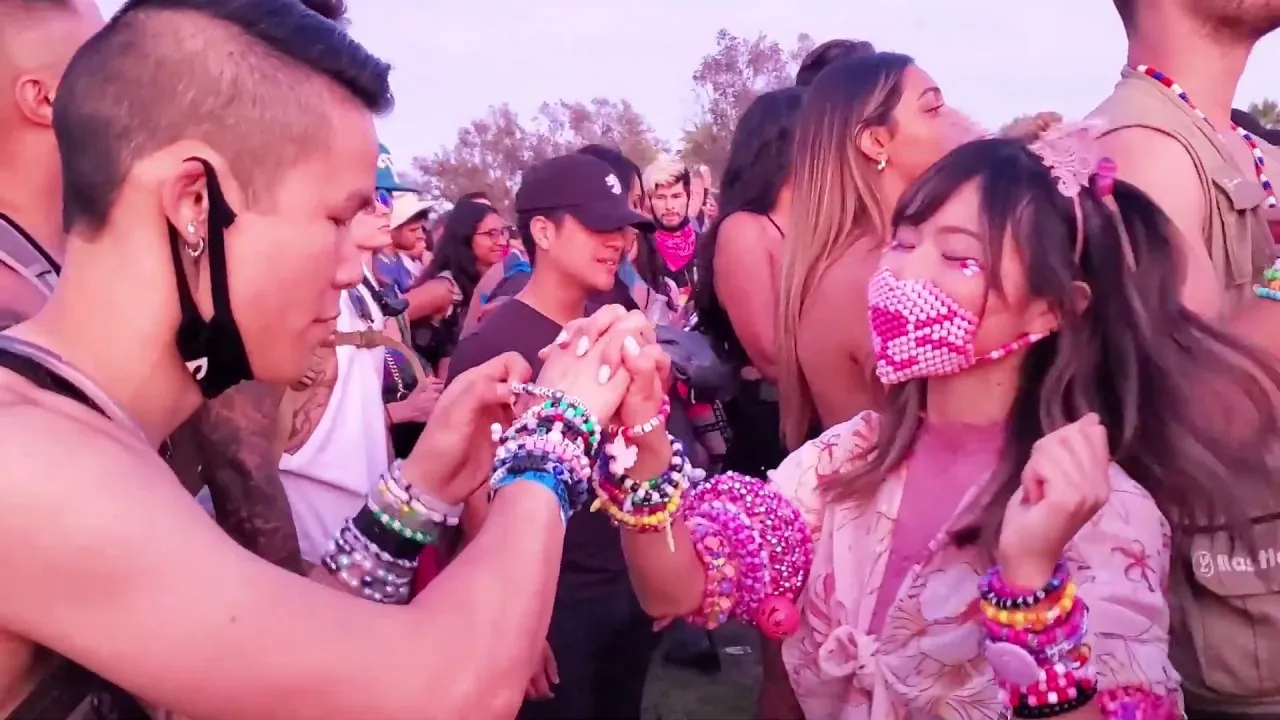The brightly colored bead accessories, known as kandi, have been a staple image of US rave culture for decades. Ravers pour precious time and love into crafting these bracelets, which have become an unmistakable symbol of their community. However, another music fandom is shaking things up with its own version of this iconic accessory.
As Taylor Swift’s massively popular ERAS tour took the country by storm, a curious trend emerged among her followers. Swifties began sporting friendship bracelets that closely resemble kandi, leaving many ravers scratching their heads. This has led to the question: Did Taylor Swift fans “steal” kandi from ravers?
While the simple answer is no, the debate reveals an interesting story about how a simple bead bracelet became the symbolic staple of an entire culture, and it raises questions about whether any single group can truly claim the tradition.
Same Materials, Different Origin Stories
Accounts of people using bead-making and trading as a means of signaling social bonds and identities exist throughout human history. Friendship bracelets became a popular trend among kids in the 80s and 90s, and some suggest that both kandi and Taylor Swift’s modern version of the accessory draw their origins from this era.
According to Taylor Swift fans, friendship bracelets started trending in response to the track “You’re On Your Own Kid,” in which Swift reflects on her childhood and the pressures of growing up quickly. Jamie Deese, a raver and dedicated Taylor Swift fan, explains: “There’s one line in the song that says, ‘So make the friendship bracelets and take the moment and taste it.’ I think it was a nostalgic thing for a lot of her adult fans because she’s saying take the time to enjoy the little things in life. Do it, even if people think it’s silly.”
The story of how kandi became part of rave culture has a few different versions. Some claim the bracelets were originally made from real candy, while others say bead bracelets were used as a form of drug paraphernalia in the underground scene. Despite some venues banning kandi in the 90s and early 2000s due to its associations, it became a fashion trend among underground circuits. Over time, ravers started making and trading kandi to promote values like peace, love, unity, and respect (PLUR) and to signal belonging to the scene.
Kandi: The Bracelet That Became The Centerpiece Of A Movement
Today, kandi plays three primary roles in rave culture. First, it serves as an identity badge, signaling pride in being a raver. David Michael, founder of the online kandi shop KandiBar, explains that many customers seek inspiration for expressing their membership in the community. “It also says I’m open to you talking to me. If I’m wearing kandi, I’m part of this community,” he says.
Trading and gift-giving kandi is a core tradition in rave culture, often marked by a special handshake. This practice fosters connections among ravers, even outside the rave scene. Deese recalls bonding with a Starbucks barista over a kandi bracelet, highlighting the sense of belonging these interactions bring.
Crafting kandi is also a cherished creative outlet. Both novices and seasoned creators use kandi to express themselves, often incorporating uplifting messages into their designs. Michael emphasizes the importance of spreading positivity through kandi: “When I work with a team to put together the Kandi phrases we publish every year, we take it as seriously as songwriting. We have to be responsible for the fact that we’re putting these messages out into the world.”

When Two Worlds Collide
Kandi culture is intimately tied to US dance music history and its values of peace, love, unity, and respect. However, not all ravers have reacted positively to Taylor Swift fans’ adoption of kandi-like friendship bracelets. Some believe Swifties have appropriated the idea without giving credit to rave culture.
This clash highlights an identity crisis within the rave community. As the scene becomes more popular, seasoned ravers fear their culture is eroding. The friction with Swift’s fandom is the latest evolution of this tension.
Despite these concerns, some believe the hostility is counterproductive. Deese points out that reacting negatively goes against the PLUR values central to kandi culture. She suggests that Swifties and ravers can bond over their shared love of bead accessories. “If you’re gonna talk about unity, Swifties and EDM people can unite. Just let them call it friendship bracelets, and you can still wear your kandi and do your thing with it. The world will keep turning, and it’s going to be okay.”
Michael echoes this sentiment: “If we take PLUR seriously, then spreading the tradition to new communities is a net positive for humanity, whether or not it looks exactly like the way we do it. The rave community getting credit is not the point.”




